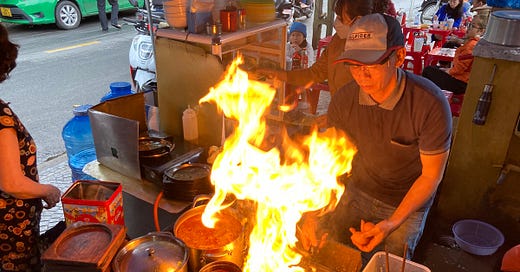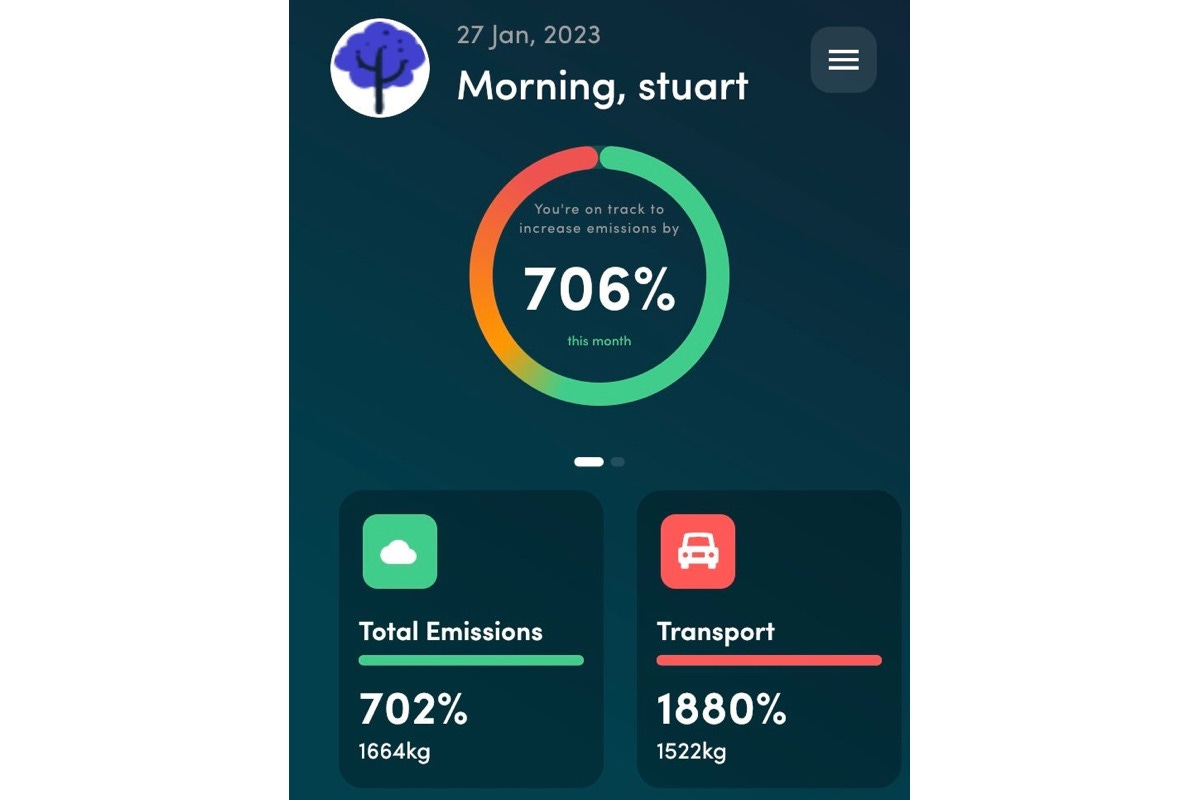One of the many aspects travel gets flogged over are its carbon emissions. As I’ve written in the past, if you’d like to over-contribute in setting the planet on fire, getting on a plane works best. What about if you don’t? What about if you’d prefer to minimise your emissions? Skipping domestic flights is the obvious first step, but what next? With this in mind, over my recent three-week trip to Vietnam, I decided to track my carbon. Here’s what I found.
Before anything, I needed to decide what I should measure. Transport was a no-brainer, but what about food and accommodation? With flights removed, both can be significant contributors, but how significant? Well, it depends. How do you travel? What do you eat and drink? Where do you stay? It turns out no two travellers are the same.
Taking train-spotting to the next level. Photo: Stuart McDonald.
I needed a system that would track not only flights, but other transport, food and hotels. In the end I settled on two, one an app that I could use as I went, and the other a website I could populate at the end of my trip. There were pros and cons to each, and neither did everything I wanted to my satisfaction. That said, both show promise, and it will be interesting to see how they develop over time.
The two systems I tried out were the Capture app and the Path Net Zero calculator. While Capture has some usability issues, it is the more appropriate for travellers looking to measure their emissions as they go. If you’re a tour company wanting to figure out the emissions of a trip, Path Net Zero is by far the better option. I used Capture as I went, then at the end of it, inputted the data from Capture into Path Net Zero.
Capture would wake me each morning with an update on my environmental vandalism. Happy days.
There are some important differences between the two. Capture doesn’t include accommodation while Path Net Zero does. Each takes a different approach to food. In both you can calculate transport by distance or time, and as I used time for Capture, I used the same for Path Net Zero. Despite this, the results were often quite different.
As an example, Capture suggested 1,229.80kg for my two flights while Path Net Zero scored it at 824.52kg. This highlighted how tricky flying can be. How full was the flight, what class was flown (Path Net Zero allowed me to nominate class, Capture doesn’t). What type of plane was it? How was the weather? These can all impact the amount of emissions allocated. That said, in the scheme of things, does it matter? Probably not—flying is the wrecking ball. Using Capture’s numbers, the two flights accounted for a whopping 74% of my total emissions.
Tuk tuk versus Airbus at a glance with Path Net Zero.
Ok, so we all know flights suck for the planet, but what about if we removed flights? Then it got more interesting. With flights removed, train travel jumped to first place, at 43%, then food (26%), motorbike (15%) and car (12%). What about accommodation you ask? A mere 5%. Why? I stay in small hotels and homestays.
If you thought flights were hard, measuring accommodation was a veritable snake pit. For most hotels, electricity is the main emissions source—air-con, kitchens, laundry, pools, hot water, all need power. The more rooms, the more pools, the more restaurants, the more power. Despite what five-star resorts might proclaim, more often than not they are abject wrecking balls environmentally. They’re also some of the worst greenwashing scoundrels on the planet.
With an environmental vandalism pie-chart, air-travel wins.
I stayed at six places during my trip, all but one with twelve rooms or less, and only one had a pool. When it came to figuring out hotel emissions, rather than ask the check-in desk for their meter readings, I turned to the books.
The most useful was Carbon Footprint Assessment of Home-Stays in Thailand by Koiwanit and Filimonau. It looked at homestays in Ranong province, using actual data, and threw out real numbers. I took these figures, then doubled them for my stay—inexact I know. Path Net Zero’s hotel estimate was double mine, but they only go down to two-star properties.
Then I looked for papers on the emissions of flasher properties—you know where this is going right? First I grabbed one that looked at lux hotels in Taiwan—Analysis And Benchmarking Of Greenhouse Gas Emissions Of Luxury Hotels by Huang, Wang and Wang. Then, for the middle range, An Assessment Of The Environmentally Sustainable Hotel Operation: The Case Of Centara Hotels & Resorts, Thailand by Baxter and Srisaeng, worked well.
All those horizon pools add up.
Let me save you some reading time. Where the average of my budget digs came in at under 2kg a day, the midrange Centara was 37.88kg per day and five stars in Taiwan was 50kg. Note, these are average numbers. Throw them across a three-week stay and the 21kg of my stays was almost 720kg with Centara and 950kg with luxury. There is a fair chance my estimate for budget emissions was low, but doubling the research numbers was a good baseline. I added more still for the joint with a pool.
That said, there was no way on earth I was going to get my accommodation-related emissions up to 950kg. So, the best way to reduce your vacation emissions after removing flights, is to avoid five-star hotels. They are a garbage fire of emissions masked by certified greenwashing. Avoid. Instead, stay at small homestays where you’ll save money and may well have a better time. You’ll also have other positive impacts you’ll struggle for at some encroaching pile of concrete with bamboo straws.
Ok, now that I got that off my chest, lets move on.
Meet emission-creep as accommodation moves from 5% to 70% of your emissions.
The next quagmire is food, which Capture and Path Net Zero take different approaches to. The former gives six options: Lots of meat, medium meat, low meat, pescatarian, vegetarian and vegan. This reflects the fact that less meat equals lower emissions. Path Net Zero takes a different approach listing meals by meal type, say American breakfast or continental breakfast, with other meals split between meat, fish or vege, each with a different weighting. This was a bit too fiddly for me, particularly as I was stuffing face with bowls of noodles. I stuck with Capture’s approach.
The thing with food, or rather, meat, is that, like flights, it depends. A few strands of some unlucky local cow tossed into a bowl of phở has a very different emission range to an imported Australian three-inch-thick grain-fed, massaged-daily air-freighted (but still unlucky) cow. It depends how much you want to get into the number crunching. Concerned? Skip the Argentinian Steakhouse and grab a phở on the street.
Local street food isn’t always low on carbon… Photo: Stuart McDonald.
In my case, in three weeks, of all my eating, all but four meals were on the street, so for most days I chose medium meat or low meat. This gave me scores of 5.63kg or 4.67kg per day. The total over three weeks was a few bowls over 110 kg. I don’t drink, so imported alcohols etcetera were not on my radar.
Lastly, there’s ground transport. For trains, neither tool had an option for “clapped out Vietnam locomotive powered by dirty fuel.” I’d guess the data comes from Euro trains, but I’m not sure on this. Same goes for vehicles and so on. Is the car or bike electric? I guess these options will come in down the road as the solutions develop.
In the scheme of things though, it is important to keep a bit of perspective. If you want to go wild and have some crazy imported meal, do so, but try and balance it out with a few extra bowls on the street. If you want to minimise your emissions, here are my numbers-assisted takeaway five points, in order of impact:
Do not fly domestically.
Avoid high-end hotels.
Don’t stay in a place with a swimming pool unless you need/want it.
Slow down, spend longer in each place so you use ground transport less.
Eat less meat.
The first two, are to my mind, no brainers. The other three are more calls for moderation. Think about your impact and act on that—and eat more phở.
Couchfish is 100 per cent independent and reader-supported. If you’re not already a subscriber, and you’d like to show your support, become a paying subscriber today for just US$7 per month—you can find out more about Couchfish here—or simply share this story with a friend.
Don’t forget, you can find the free podcasts on Apple, Pocket Casts and Spotify as well as right here on Couchfish.



















Share this post